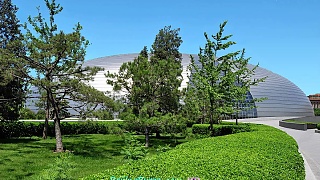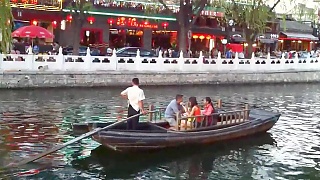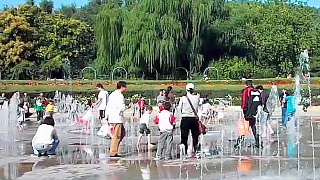With Beijing Old Liu ...
[640],shadow=true,start=,stop=Welcome to Beijing Botanical Garden
Explore the rich diversity and stunning beauty of Beijing Botanical Garden.
Introduction
The Beijing Botanical Garden is a large botanical garden located in the western outskirts of Beijing, China. It covers a vast area and is dedicated to the collection, cultivation, and display of a wide variety of plants.
Location
The Beijing Botanical Garden is located in the Haidian District of Beijing, near the Western Hills and Xiangshan Park.
History
The Beijing Botanical Garden was established in 1955 and has since become one of the most significant botanical gardens in China. It was designed to serve both scientific and recreational purposes, providing a space for research, conservation, and public education about plant biodiversity.
Attractions
- Peony Garden: A stunning garden featuring a vast array of peony varieties, particularly beautiful in late spring.
- Tropical Conservatory: Home to a wide variety of tropical and subtropical plants, including rare and endangered species.
- Rose Garden: An extensive collection of roses, showcasing both traditional and modern varieties. Plus fountains.
- Medicinal Herb Garden: Features a variety of plants used in traditional Chinese medicine.
- Orchid House: Displays a large number of orchid species and hybrids.
Activities
- Guided Tours
- Educational Workshops
- Photography
- Botanical Research
- Seasonal Festivals and Events
Facilities
- Visitor Center
- Restrooms
- Gift Shops
- Cafes and Restaurants
- Parking Lots
- Wheelchair Access
Visitor Tips
- Wear comfortable walking shoes.
- Bring water and snacks, especially if you plan to stay for several hours.
- Visit early in the morning or late in the afternoon to avoid crowds.
- Check the weather forecast and dress appropriately.
- Respect the plants and wildlife; do not pick flowers or disturb animals.
Beijing, the capital city of China, is a vibrant metropolis steeped in history, culture, and modernity. Here's a brief overview of what you can expect as a tourist in Beijing:
Historical Landmarks:
The Great Wall of China: One of the most iconic structures in the world, the Great Wall is easily accessible from Beijing. Mutianyu and Badaling sections are popular among tourists.
Forbidden City (Palace Museum): A UNESCO World Heritage Site, this vast imperial palace complex was home to Chinese emperors for over 500 years. It houses numerous halls, courtyards, and historical artifacts.
Temple of Heaven: A masterpiece of Chinese architecture, this ancient temple complex served as a place of worship for emperors to pray for good harvests.
Summer Palace: A stunning ensemble of lakes, gardens, and palaces, the Summer Palace served as a retreat for emperors during the Qing dynasty.
Tiananmen Square: One of the largest city squares in the world, Tiananmen Square is flanked by important landmarks such as the Monument to the People's Heroes, the Great Hall of the People, and the Mausoleum of Mao Zedong.
Cultural Sites:
Beijing Hutongs: Explore the narrow alleyways and traditional courtyard residences of Beijing's historic neighborhoods. You can take a rickshaw tour or simply wander around on foot.
Beijing Opera: Experience traditional Chinese opera performances at venues like the Liyuan Theater or the Chang'an Grand Theatre.
798 Art District: A hub of contemporary art and culture, this former industrial area is now home to numerous galleries, studios, and cafes.
Modern Attractions:
Olympic Park: Visit iconic structures such as the Bird's Nest (National Stadium) and the Water Cube (National Aquatics Center) from the 2008 Beijing Olympics.
CBD (Central Business District): Marvel at the futuristic skyline of Beijing's modern business district, which includes landmarks like the CCTV Headquarters and the China World Trade Center Tower III.
Culinary Delights:
Peking Duck: Indulge in Beijing's most famous dish, crispy roast duck served with pancakes, scallions, and hoisin sauce.
Street Food: Explore the city's vibrant street food scene and sample local delicacies like jianbing (savory crepes), lamb skewers, and dumplings.
Practical Tips:
Transportation: Beijing has an extensive public transportation system, including the subway, buses, and taxis. However, traffic can be heavy, so plan your travels accordingly.
Language: While English is not widely spoken, especially outside tourist areas, many signs and transportation announcements are in English. It's helpful to carry a translation app or a phrasebook.
Weather: Beijing experiences four distinct seasons, with hot summers and cold winters. The best times to visit are spring (April to June) and autumn (September to October) when the weather is mild and comfortable.
Etiquette: Respect local customs and traditions, such as removing your shoes before entering someone's home and using both hands to pass or receive items.
Beijing offers a rich tapestry of experiences for tourists, blending ancient heritage with modern innovations. Whether you're fascinated by history, culture, or culinary delights, there's something for everyone in this dynamic city.
 BeiJing Botanical Garden and the Reclining Buddha Temple (WoFoSi)
BeiJing Botanical Garden and the Reclining Buddha Temple (WoFoSi)

















